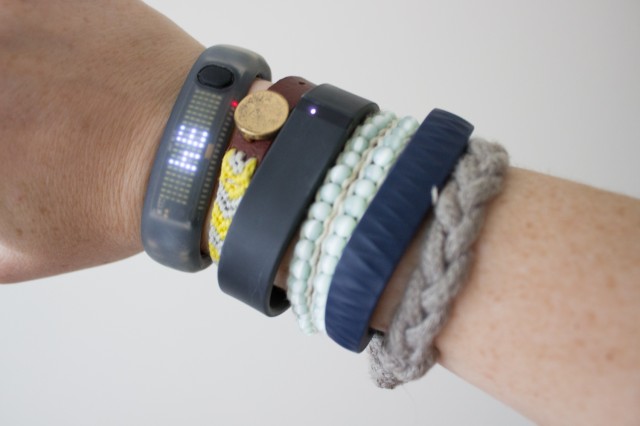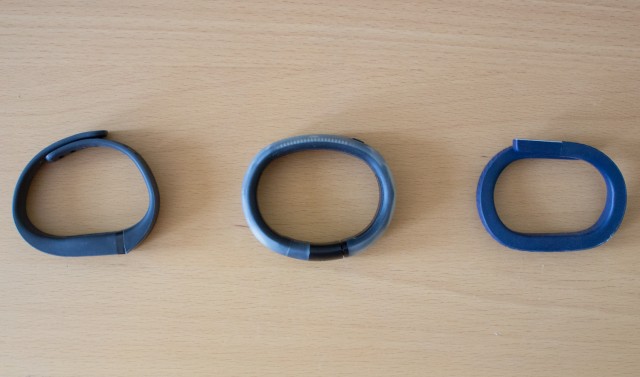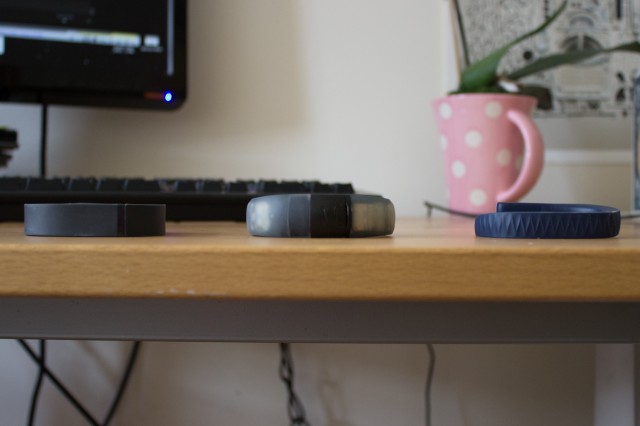
There’s nothing like an obesity epidemic to remind people that many of us have totally lost touch with what our bodies are doing all day. The disconnect between our conception of fitness and what we're doing to achieve it has grown faster than we can comprehend. We are in a fitness hole, trying to count our way out in calories, steps, pounds, heartbeats per minute, and hours of sleep per night.
The reason fitness devices have enjoyed such popularity is that they automate this tracking. And what they can’t automate, they make fairly easy to log. There's no obvious answer to our sedentary, overeating culture, but fitness bands offer a way toward a little more mindfulness about the ruts we may have fallen into over the course of our daily lives.
But given how trendy fitness dongles, bands, and apps have become, there’s a glut of them out there to sort through. Today we'll take a look at three of the most popular fitness bands: the Jawbone Up ($130), the Fitbit Flex ($100), and the Nike Fuelband ($149). Different interfaces will work for different people, so even if you don’t agree with our pick for the best device, we'll provide enough information to help you make an informed decision. We chose to stick to fitness bands, because they are the most recent evolution of the format. More (and perhaps more discreet) peripherals like the regular Fitbit are still available.


Before we get to the evaluation, a little about my fitness profile: I’m a pretty active person, and the foundation of my routine is running. I average 15-20 miles per week and do some free-weight-type workouts twice a week. I also get in one or two cycling trips per week, generally between five and 10 miles. I would not personally buy a fitness band for motivation purposes, but I might get one out of curiosity to plumb the depths of my own sedentary office life.
Look and feel
The Fuelband is the chunkiest of the three, and it looks most distinctly like a futuristic prison cuff. It includes a small LED display and button that allow you to see the “fuel” accrued for the day, as well as calories, steps, and active time. It goes on and off the wrist by an interlocking clasp where the USB interface is concealed.
The Jawbone Up is a bendy wrap bracelet that you distort to clasp onto your wrist. It has no display, but on one end there is a button that allows you to put the band into various modes (press and hold to toggle between sleep and waking mode, press twice and then hold to log an activity, and so on). The other, disconnected end of the bracelet has a 3.5 mm jack concealed by a cap that must be plugged into a device running Android or iOS to sync the activity log to an app.
The Fitbit Flex closes around your wrist like one of those paper bracelets you get when you enter a fairground or particularly suspicious nightclub. But it's obviously removable, with a set of prongs that snap into a set of holes. The only display is a set of five LEDs that represent your step progress for the day (more LEDs equal more steps) that light up when you pet the device’s face twice. Encased in the rubber bracelet is a small device about the size of an earplug that can be removed to charge it via a USB adapter. The device will also vibrate when you hit your step goal for the day.
All of the devices are comfortable and not any more noticeable than a regular bracelet. I have a pretty small wrist, but the small size of both the Fitbit and Jawbone Up fit snugly.
The small size of the Fuelband, however, jiggles around on the smallest part of my wrist. The Fuelband is the least adjustable of the three (Fitbit Flex has a series of notches, and the Jawbone Up deforms to accommodate larger wrists), so it may not be the best choice for those who don’t want to risk feeling an accessory wobbling around their wrist all day. Despite the looseness, the function of the Fuelband doesn’t seem to be affected, and I didn’t experience any extraneous step-logging.
After having used the Fuelband for several weeks, I’ve developed a Pavlovian fear of its clasp. On more than one occasion, I caught my tender wrist skin while trying to snap it closed. Once I even drew blood. I fight this battle with the Fuelband every time I take a shower—Nike states that the Fuelband is fine with shower-level water exposure, but I’m wary of risking a $149 device in a daily water onslaught—so I suffer.
The design of the Fitbit Flex has its own problem. There is no delicate way to put this, nor a way that does not immediately implicate me as a slovenly human being, so I’ll start by saying that I swear I’m clean. I do work out regularly and sweat, but I also take showers regularly. That all said, the construction of the Fitbit Flex lends itself to odor.
I’ve noticed on multiple occasions that when I remove the dongle that fits inside the rubbery band part of the Fitbit Flex, the dongle cavity will have a repulsive smell, presumably from having played host for a few days to a smorgasbord of whatever invisible scented particles it has grafted from the surface of my wrist, with a little sweat mixed in for good measure.
The time it takes the Fitbit Flex to charge again is usually long enough to air out the cavity so that the smell goes away. A quick swipe with a paper towel also helps. There’s not a ton to be done about this problem, save giving your Fitbit Flex a daily or semi-daily internal polish. The smell isn’t so strong that passersby will be giving you dirty looks. If it’s on my wrist, I can barely smell it with my nose pressed up against it. It’s not a huge cause for concern, just kind of gross and not a problem that the other two fitness bands share.
Each device syncs a different way, and each way is probably slightly more aggravating when trying to use them all together rather than one at a time. The Fuelband uses Bluetooth to sync with a smartphone app (iOS-exclusive, at the moment), which requires that you either tax your battery a bit to be able to sync at a whim or turn Bluetooth on and off every time you want to log your activity.
Since you can dip in to see how you’re doing just by checking the Fuelband’s wristband display, actual syncs are a little less tempting than with the Jawbone UP or Fitbit Flex. But the Fuelband app provides you with updates on goal-meeting streaks, your personal best days, and so forth. You can miss out on a good amount of motivation if you only log activity when absolutely necessary.
We mentioned the Jawbone Up’s jack, which has to physically interface with the phone to sync. This is cumbersome, as it requires physically removing the bracelet from your wrist, popping off an easily lost piece, and plugging it into your phone for a few seconds (Jawbone recommends doing this twice a day). Despite all the physical steps, we found this slightly less annoying than flipping Bluetooth on and off for the Fuelband to conserve battery, but neither are really optimal.
The Fitbit Flex, like other Fitbit devices, syncs wirelessly with a dongle plugged into your computer any time the two of them cross paths. This is delightfully hands-off, even if it requires your computer to be on and alert all the time to receive your updates. Your Fitbit account then e-mails you with updates on your progress for the day.
The potential annoyance here is that you can’t get updates to your progress when you’re out and away from your computer. But the passive logging is great for all the days that follow the first few, after the initial excitement has worn off and you end up going a day or five without updating your account.
There is a Fitbit mobile app, too, but it's not set up to interface with the app by default—out of the box, information goes from wristband to dongle to Web to app, and there are no shortcuts in between. With a few interface switch flips, you can turn on Bluetooth syncing via the app so that you can drop in to see your progress at will (though the app is not able to access the Bluetooth chips of all phones, even if they are Bluetooth 4).
You can view your historical progress and do things like enter activities or log food consumed for the day within the Fitbit app, but it is not laid out the best it could be. For example, you can see how many hours of sleep you logged in the main interface, but to see your wakeup/sleep-time spread, you have to burrow into the More menu and then select sleep. By contrast, the two types of information are presented together in the Web interface.
-
The food logging interface for the Fitbit Flex...
-
....and the food-logging interface for the Jawbone Up.
Both the Fuelband and Fitbit both have Web interfaces where you can analyze your progress. For the Jawbone Up, everything, including analysis, is contained within the app.
As for battery life, the Fuelband and Jawbone Up claim to last around 10 days between charges. We found these figures to be accurate in our testing. The Fitbit Flex claims to last 6-7 days on a single charge, which we also found to be accurate.
I was usually able to charge the devices while sitting at my desk working, as each of them took only an hour or so to fill up again. The Fitbit Flex and Jawbone Up both come with extra dongles that interface with USB (a proprietary docking port for the Flex, and a 3.5 mm-to-USB converter for the Up). The Fuelband plugs directly into a USB port, but because it’s a loose fit and lacks the external USB structure, we couldn’t get it to hang right and charge from every USB port we tried. Most, including wall chargers, worked fine.
reader comments
145